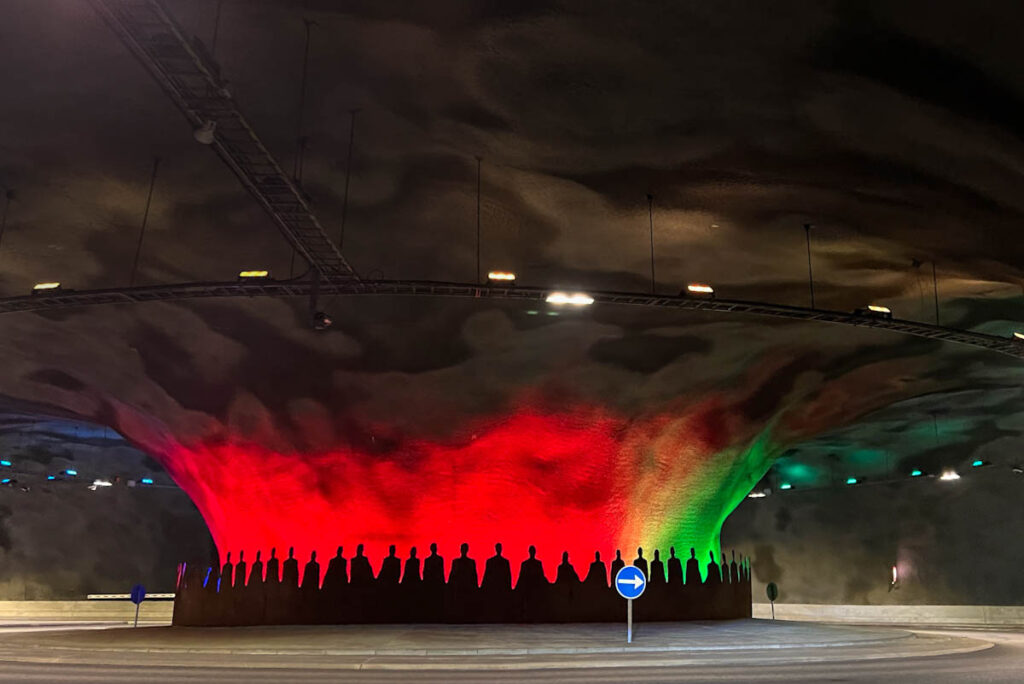You might think that traveling around the Faroe Islands takes quite a bit of time, as the archipelago consists of 18 islands. Nothing could be further from the truth. The Faroese are masters at building tunnels, making it easy to travel from one island to another. So far, only a few islands are accessible by boat or helicopter. Currently, there are 22 tunnels, including sea and mountain tunnels. In the coming years, a subsea tunnel to the southernmost island, Suðuroy, will open. Several more mountain tunnels are also planned, eliminating the need to navigate treacherous mountain passes.
Every tunnel in the Faroe Islands is a real attraction
And that’s no exaggeration. Whether you drive through one of the oldest “1-lane” tunnels in the Faroe Islands or a modern tunnel with a roundabout, every tunnel is an experience. Some tunnels are lit with blue lighting, giving the impression of traveling through seawater. Truly impressive! I would love to stop in every tunnel to take photos, but of course, that’s not possible with traffic behind you. Not in the larger tunnels on the bigger islands and certainly not in the single-lane tunnels.
The longest tunnel in the Faroe Islands, with a roundabout
The longest tunnel in the Faroe Islands is the 11.3-kilometer-long Eysturoyartunnilin, opened in 2020. The tunnel connects the islands of Streymoy and Eysturoy. Close to Eysturoy, at a depth of 189 meters below the water’s surface, you’ll find the roundabout. It’s not just functional, but also a place where art is displayed. You might find various photos of the roundabout online, each showcasing different colors and shapes. From the roundabout, you can take the exit to either Runavik or Strendur. Thanks to the tunnel, the journey from the capital, Tórshavn, to Runavik or Strendur has become much easier and faster. Before the tunnel, the trip would take over an hour; now, you can reach your destination in just 15 minutes.
In second place is the 10.8-kilometer-long Sandoyartunnilin, which opened in 2023. It connects Streymoy with Sandoy. Immediately after it opened, the ferry service between the two islands was discontinued.
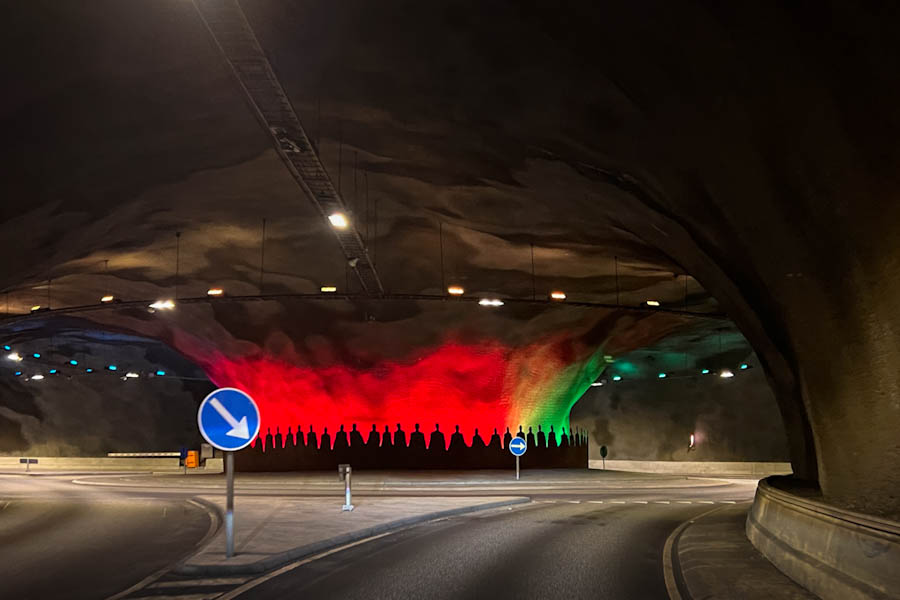
The narrowest tunnels in the Faroe Islands
The Eysturoyartunnel is new and nice and wide, but there are a few tunnels in the Faroe Islands that are incredibly narrow. The narrowest tunnels are the 1.7-kilometer-long Árnafjarðartunnel (1965) and the 2.1-kilometer-long Hvannasundstunnel (1967). Both are located on the island of Borðoy and are only 2.8 meters wide. One lane only in these tunnels! These are also the two oldest tunnels in the Faroe Islands.
During my visit to the Faroe Islands, I was able to drive through these tunnels, but since the opening of new tunnels on Borðoy in 2024 (see later in this article), these two tunnels have been closed.
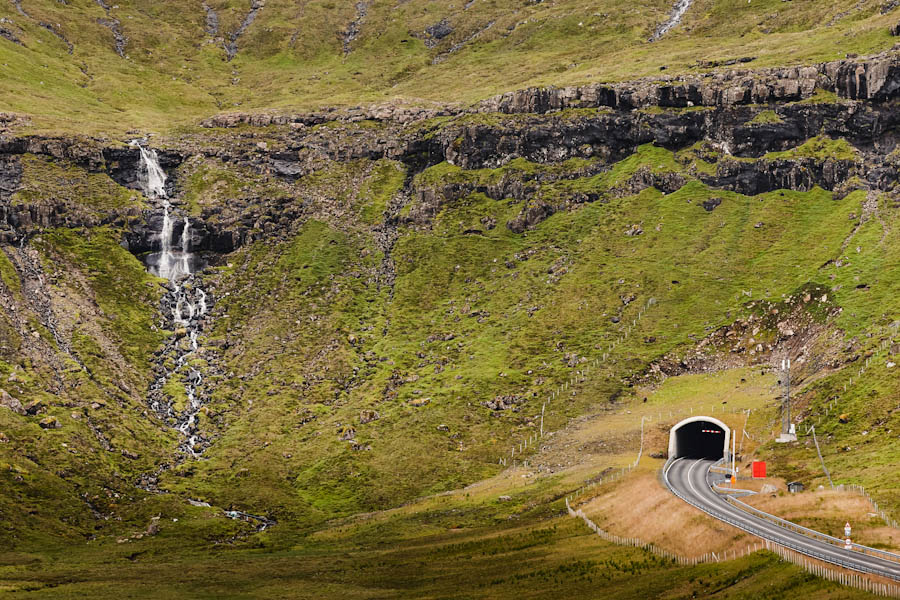
Blokkfloytan, the nickname of the five-tunnel island Kalsoy
Single-lane tunnels can also be found on the island of Kalsoy. In fact, all the tunnels on this island are just wide enough for one car. Kalsoy is one of the few islands that can only be reached by ferry or helicopter. The island is long and narrow: 18 kilometers long and 3 kilometers wide at its widest point. The five tunnels on the island have earned Kalsoy the nickname Blokkfloytan (flute). There is only one connecting road: the 16.6-kilometer-long Kalsoyarvegur. If you drive from the harbor in Syðradalur to the village of Trøllanes, you’ll spend 5.5 kilometers, or about one-third of the total route, inside the mountain mass.
The tunnels on Kalsoy were built between 1979 and 1985 and were a godsend for the (few) inhabitants of Kalsoy. No more long, dangerous walks over mountain ridges along deep cliffs, in all kinds of weather. The longest tunnel on Kalsoy is the 2.2-kilometer-long tunnel from Mikladalur to the furthest village, Trøllanes.
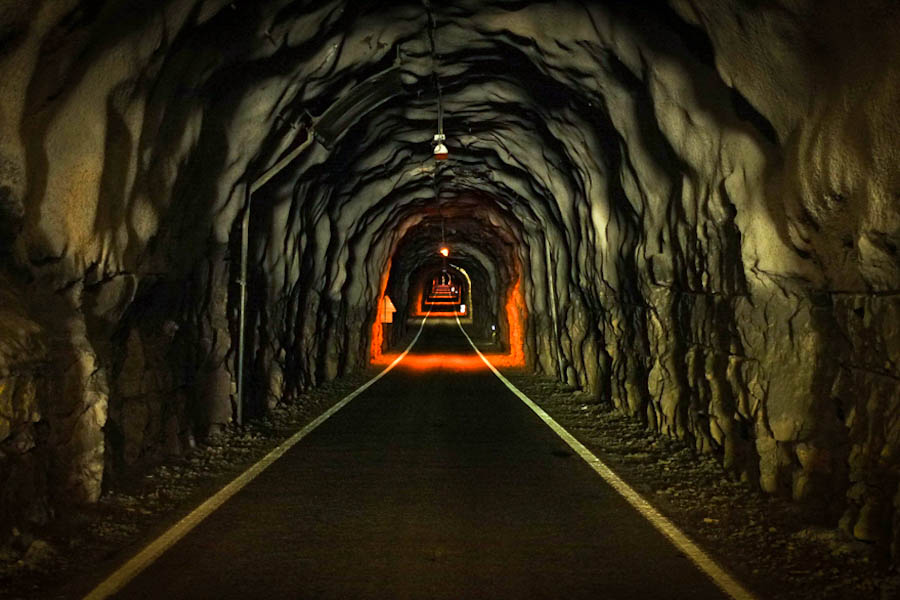
New tunnels on the Faroe Islands
The newest tunnels were completed in 2024 and can be found on the island of Borðoy. The 2.2-kilometer-long Nýggi Hvannasundstunnilin connects Árnafjørður with Norðdepil and the 1.9-kilometer-long Nýggi Árnafjarðartunnilin connects Ánir with Árnafjørður. These tunnels together connect several villages on Borðoy that are now more easily accessible from Klaksvík (replacing the two oldest tunnels on the Faroe Islands, as mentioned earlier in this article). Collectively, these tunnels are also known as Tunlarnir norður um Fjall or Borðoyartunlarnir.
Tunnels under construction on the Faroe Islands
The real showpiece of the tunnels that is eagerly awaited is the Suðuroy Tunnel. This 26-kilometer-long tunnel will connect the southernmost islands Sandoy, Skúvoy and Suðuroy. However, it will still be a while before this tunnel is finished; the plan is to complete it after 2030.
There are also several mountain tunnels under construction. The 3-kilometer-long Dalstunnilin on Sandoy will replace the coastal road between Húsavík and Dalur. On Suðuroy, the 1.2-kilometer-long Fámjinstunnilin is being built to connect the villages of Øravík and Fámjin. On the island of Streymoy, work is underway on the 1.3-kilometer-long Tunnil úr Villingadali (fyrstur Havnartunnilin), which will connect two districts in Tórshavn. If everything goes according to plan, these tunnels will be in operation by 2025.
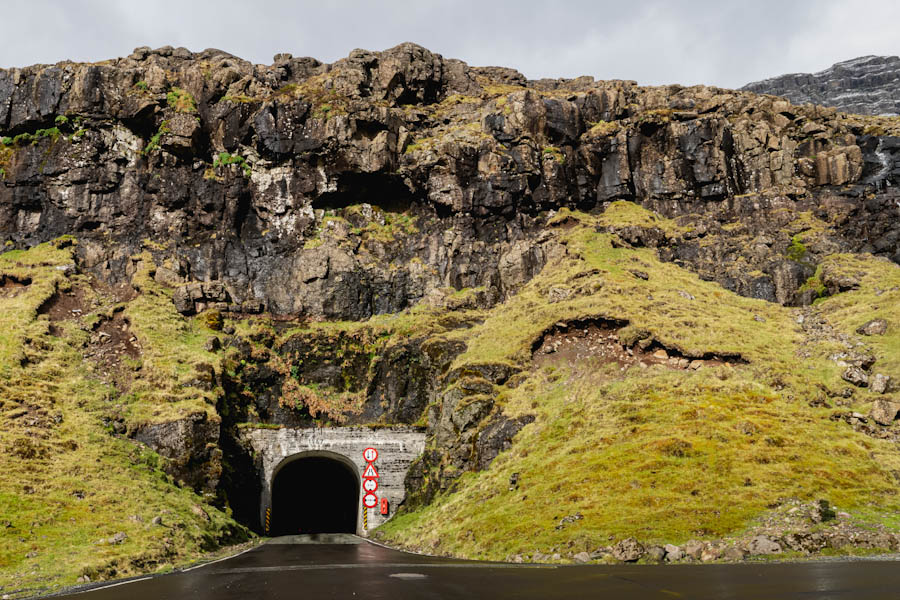
Rules in one-lane tunnels on the Faroe Islands
I’ve experienced how exciting it can be driving through a one-lane tunnel before, during my trip to the Westfjords of Iceland, where the Vestfirðir tunnel switches from two lanes to one lane halfway through. If you don’t know about this in advance, you might find yourself gripping the wheel when headlights suddenly appear! On the Faroe Islands, there’s no surprise waiting for you in the one-way tunnels; you’re well-prepared. The rule is that the vehicle with a pull-off area on its side must pull over to let the oncoming vehicle pass. These turnouts are typically found every 100 meters, so they are quite frequent. The exception to this rule occurs when a passenger car or camper meets a truck. A truck always has priority. A passenger car or camper must use the nearest turnout to allow the truck to pass, whether the turnout is on the left or right side of the tunnel.
Toll fees for the tunnels on the Faroe Islands
On the Faroe Islands, you pay a toll for the sea tunnels. You can check exactly which tunnels require toll payments and how to pay them on this website. It’s also possible to pay the toll in advance when you rent a car.
Tips for driving on the Faroe Islands
Driving on the Faroe Islands isn’t just a little different in the tunnels; it’s also something to be cautious about on the main roads. The Faroe Islands are home to about 80,000 sheep that roam freely. You’ll often encounter them and no, they don’t always move aside. Even if they’re not on the road but on the grassy shoulder, one of them might unexpectedly dash onto the road. Also, remember that headlights (or at least dim lights) are mandatory, even during the day. As in most mountainous regions of the world, ascending traffic has the right of way over descending traffic.
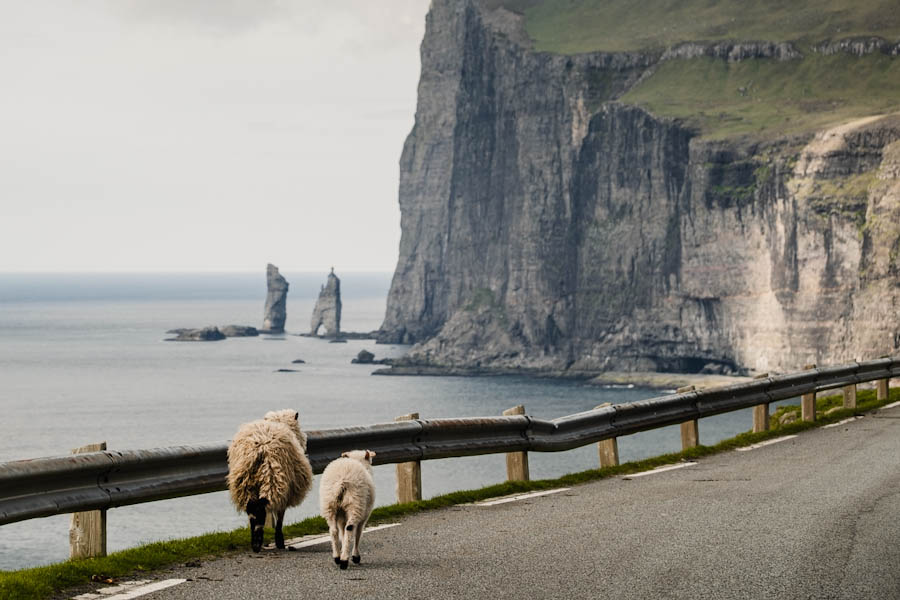
How to start your journey to the Faroe Islands
You can travel to the Faroe Islands by ferry from Denmark or by plane. The ferry departs from Hirtshals in Denmark and arrives in Tórshavn on the Faroe Islands. The journey takes about 36 hours at sea, meaning you’ll spend two nights aboard the ferry. You can fly to Denmark (Aalborg is the most convenient airport), take the train to Hirtshals and then board the ferry. Prefer flying from Amsterdam? You can, with a layover in Copenhagen or Billund. Check the options on Trip.com. Want to bring your own car? No problem! Drive to Denmark and take your car on the ferry to the Faroe Islands.
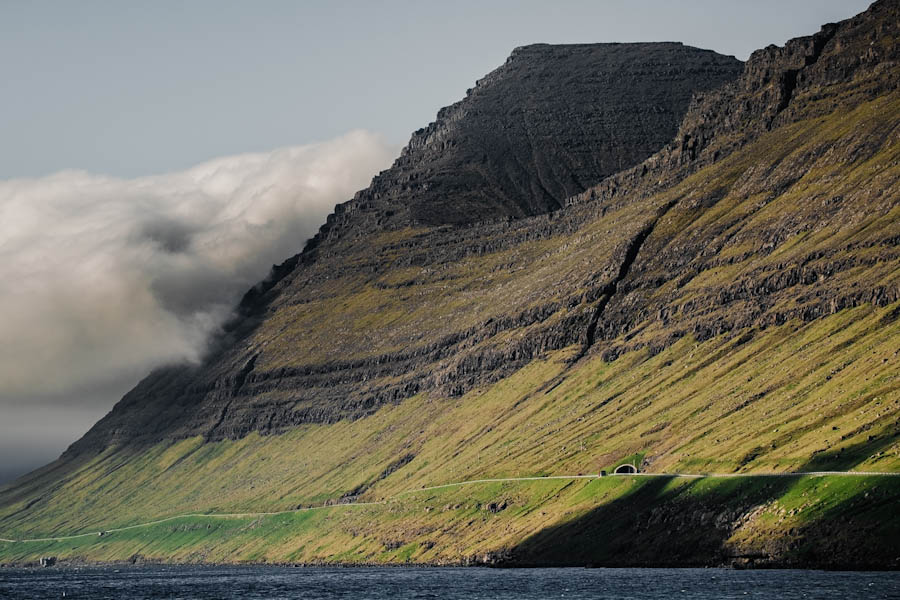
Package tours to the Faroe Islands
Prefer a fully organized trip? You can easily book a complete package to the Faroe Islands, including a ferry crossing from Denmark and stays in various accommodations on the islands, all with your own car. Alternatively, you can fly to the Faroe Islands and explore the islands with a rental car, with everything arranged in advance for a hassle-free experience. It’s a convenient and easy way to travel!
